Role of Inherited Tectonic Structures on Gravity-Induced Slope Deformations: Inference from Numerical Modeling on the Luco dei Marsi DSGSD (Central Apennines)
Abstract
:1. Introduction
2. Geological Setting
3. DSGSD and BSZ
4. Engineering-Geological Model
4.1. Rock Matrix Characteristics
| Specimen | Lithology | Unit Weight | UCS Strength | Young Modulus | Poisson Ratio |
|---|---|---|---|---|---|
| - | - | γ | σc | E | υ |
| - | - | kN/m3 | MPa | MPa | - |
| C_1 | Intact limestone | 26.1 | 71.88 | 47,736 | 0.20 |
| C_2 | Intact limestone | 26.3 | 92.83 | 72,356 | 0.28 |
| C_3 | Limestone with calcite veins | 25.6 | 40.56 | 29,088 | 0.24 |
| C_4 | Limestone with calcite veins | 26.4 | 9.30 | 6670 | 0.24 |
| Lithology | Unit Weight | UCS Strength | Young Modulus | Poisson Ratio | UCS/E Ratio | Viscosity |
|---|---|---|---|---|---|---|
| - | γ | σc | E | υ | σc/E | μ |
| - | kN/m3 | MPa | MPa | - | - | Pa·s |
| Intact limestone | 26.2 | 82.36 | 60,046 | 0.24 | 0.001394 | 2.00 × 1019 |
| Limestone with calcite veins | 26.0 | 24.93 | 17,879 | 0.24 | 0.001394 | 2.00 × 1017 |
4.2. Rock Mass Rheological Behavior
4.3. Rock Mass Joint Mechanical Behavior
5. Numerical Modeling
5.1. Slope Characterization
5.2. Calculation Stages and Physical-Mechanical Parameters
| Region | Lithology | Model | Unit Weight | Geological Strength Index | UCS Strength | Intact Rock Constant |
|---|---|---|---|---|---|---|
| - | - | - | γ | GSI | σc | mi |
| - | - | - | kN/m3 | - | MPa | - |
| 44 | Upper Cretaceous limestones | Burgers/Hoek-Brown | 25.9 | 50 | 82.4 | 12 |
| 56 | Upper Cretaceous limestones | Burgers/Hoek-Brown | 25.9 | 50 | 82.4 | 12 |
| 59 | Upper Cretaceous limestones | Burgers/Hoek-Brown | 25.9 | 50 | 82.4 | 12 |
| 98 | Highly-Jointed Level (HJL) | Burgers/Hoek-Brown | 25.6 | 35 | 24.9 | 12 |
| 99 | Highly-Jointed Level (HJL) | Burgers/Hoek-Brown | 25.6 | 35 | 24.9 | 12 |
| 100 | Highly-Jointed Level (HJL) | Burgers/Hoek-Brown | 25.6 | 35 | 24.9 | 12 |
| Region | Lithology | Model | Young Modulus | Bulk Modulus | Shear Modulus Maxwell | Shear Modulus Kelvin | Poisson Ratio | Viscosity Maxwell | Viscosity Kelvin |
|---|---|---|---|---|---|---|---|---|---|
| - | - | - | E | K | G1 | G2 | υ | μM | μK |
| - | - | - | MPa | MPa | MPa | MPa | - | Pa·s | Pa·s |
| 44 | Upper Cretaceous limestones | Burgers/Hoek-Brown | 23,217 | 14,883 | 9362 | 11,234 | 0.24 | 3.08 × 1017 | 3.08 × 1018 |
| 56 | Upper Cretaceous limestones | Burgers/Hoek-Brown | 18,279 | 11,717 | 7371 | 8845 | 0.24 | 3.05 × 1017 | 3.05 × 1018 |
| 59 | Upper Cretaceous limestones | Burgers/Hoek-Brown | 6949 | 4454 | 2802 | 3362 | 0.24 | 3.03 × 1017 | 3.03 × 1018 |
| 98 | Highly-Jointed Level (HJL) | Burgers/Hoek-Brown | 12,540 | 8038 | 5056 | 6068 | 0.24 | 2.04 × 1015 | 2.04 × 1016 |
| 99 | Highly-Jointed Level (HJL) | Burgers/Hoek-Brown | 6954 | 4458 | 2804 | 3365 | 0.24 | 2.04 × 1015 | 2.04 × 1016 |
| 100 | Highly-Jointed Level (HJL) | Burgers/Hoek-Brown | 1851 | 1187 | 746 | 896 | 0.24 | 2.04 × 1015 | 2.04 × 1016 |
| Region | Lithology | Type | Dip | Model | Joint Wall Compressive Strength | Joint Roughness Coefficient |
|---|---|---|---|---|---|---|
| - | - | - | α | - | JCS | JRC |
| - | - | - | ° | - | MPa | - |
| 44 | Upper Cretaceous limestones | Fracture | 60 | Barton–Bandis | 25 | 9 |
| Fracture | 75 | Barton–Bandis | 30 | 10 | ||
| 56 | Upper Cretaceous limestones | Fracture | 70 | Barton–Bandis | 30 | 10 |
| Fracture | 70 | Barton–Bandis | 30 | 10 | ||
| 59 | Upper Cretaceous limestones | Fracture | 75 | Barton–Bandis | 30 | 10 |
| Fracture | 70 | Barton–Bandis | 30 | 10 | ||
| 98 | Highly-Jointed Level (HJL) | Bedding | 1 | Barton–Bandis | 20 | 9 |
| 99 | Highly-Jointed Level (HJL) | Bedding | 14 | Barton–Bandis | 20 | 9 |
| 100 | Highly-Jointed Level (HJL) | Bedding | 20 | Barton–Bandis | 20 | 9 |
5.3. Numerical Model Results
6. Discussion
7. Conclusions
Author Contributions
Funding
Data Availability Statement
Acknowledgments
Conflicts of Interest
References
- Jaboyedoff, M.; Penna, I.; Pedrazzini, A.; Baroň, I.; Crosta, G.B. An introductory review on gravitational-deformation induced structures, fabrics and modeling. Tectonophysics 2013, 605, 1–12. [Google Scholar] [CrossRef]
- Bozzano, F.; Della Seta, M.; Martino, S. Time-dependent evolution of rock slopes by a multi-modelling approach. Geomorphology 2016, 263, 113–131. [Google Scholar] [CrossRef]
- Pánek, T.; Klimeš, J. Temporal behavior of deep-seated gravitational slope deformations: A review. Earth-Sci. Rev. 2016, 156, 14–38. [Google Scholar] [CrossRef]
- Discenza, M.E.; Esposito, C. State-of-art and remarks on some open questions about DSGSDs: Hints from a review of the scientific literature on related topics. Ital. J. Eng. Geol. Environ. 2021, 21, 31–59. [Google Scholar] [CrossRef]
- Di Martire, D.; Novellino, A.; Ramondini, M.; Calcaterra, D. A-differential synthetic aperture radar interferometry analysis of a deep seated gravitational slope deformation occurring at Bisaccia (Italy). Sci. Total Environ. 2016, 550, 556–573. [Google Scholar] [CrossRef] [PubMed]
- Delchiaro, M.; Della Seta, M.; Martino, S.; Dehbozorgi, M.; Nozaem, R. Reconstruction of river valley evolution before and after the emplacement of the giant Seymareh rock avalanche (Zagros Mts., Iran). Earth Surf. Dyn. 2019, 7, 929–947. [Google Scholar] [CrossRef] [Green Version]
- Jarman, D.; Harrison, S. Rock slope failure in the British mountains. Geomorphology 2019, 340, 202–233. [Google Scholar] [CrossRef]
- Discenza, M.E.; Esposito, C.; Komatsu, G.; Miccadei, E. Large-Scale and Deep-Seated Gravitational Slope Deformations on Mars: A Review. Geosciences 2021, 11, 174. [Google Scholar] [CrossRef]
- Delchiaro, M.; Della Seta, M.; Martino, S.; Nozaem, R.; Moumeni, M. Tectonic deformation and landscape evolution inducing mass rock creep driven landslides: The Loumar case-study (Zagros Fold and Thrust Belt, Iran). Tectonophysics 2023, 846, 229655. [Google Scholar] [CrossRef]
- Chigira, M. Long-term gravitational deformation of rocks by mass rock creep. Eng. Geol. 1992, 32, 157–184. [Google Scholar] [CrossRef]
- Hippolyte, J.C.; Brocard, G.; Tardy, M.; Nicoud, G.; Bourles, D.; Braucher, R.; Ménard, G.; Souffaché, B. The recent fault scarps of the Western Alps (France): Tectonic surface ruptures or gravitational sackung scarps? A combined mapping, geomorphic, levelling, and 10Be dating approach. Tectonophysics 2006, 418, 255–276. [Google Scholar] [CrossRef]
- Bozzano, F.; Martino, S.; Montagna, A.; Prestininzi, A. Back analysis of a rock landslide to infer rheological parameters. Eng. Geol. 2012, 131, 45–56. [Google Scholar] [CrossRef]
- Esposito, C.; Di Luzio, E.; Scarascia Mugnozza, G. Mutual interactions between slope-scale gravitational processes and morpho-structural evolution of central Apennines (Italy): Review of some selected case histories. Rend. Fis. Acc. Lincei 2014, 25, 151–165. [Google Scholar] [CrossRef]
- Alfaro, P.; Delgado, J.; Esposito, C.; Tortosa, G.F.; Marmoni, G.M.; Martino, S. Time-dependent modelling of a mountain front retreat due to a fold-to-fault controlled lateral spreading. Tectonophysics 2019, 773, 228233. [Google Scholar] [CrossRef]
- Esposito, C.; Di Luzio, E.; Baleani, M.; Troiani, F.; Della Seta, M.; Bozzano, F.; Mazzanti, P. Fold architecture predisposing deep-seated gravitational slope deformations within a flysch sequence in the Northern Apennines (Italy). Geomorphology 2021, 380, 107629. [Google Scholar] [CrossRef]
- Della Seta, M.; Esposito, C.; Marmoni, G.M.; Martino, S.; Scarascia Mugnozza, G.; Troiani, F. Morpho-structural evolution of the valley-slope systems and related implications on slope-scale gravitational processes: New results from the Mt. Genzana case history (Central Apennines, Italy). Geomorphology 2017, 289, 60–77. [Google Scholar] [CrossRef]
- Discenza, M.E.; Martino, S.; Bretschneider, A.; Scarascia Mugnozza, G. Influence of joints on creep processes involving rock masses: Results from physical-analogue laboratory tests. Int. J. Rock Mech. Min. Sci. 2020, 128, 104261. [Google Scholar] [CrossRef]
- Vick, L.M.; Böhme, M.; Rouyet, L.; Bergh, S.G.; Corner, G.D.; Lauknes, T.R. Structurally controlled rock slope deformation in northern Norway. Landslides 2020, 17, 1745–1746. [Google Scholar] [CrossRef]
- Martino, S.; Prestininzi, A.; Scarascia Mugnozza, G. Geological-evolutionary model of a gravity-induced slope deformation in the carbonate Central Apennines (Italy). Q. J. Eng. Geol. Hydrogeol. 2004, 37, 31–47. [Google Scholar] [CrossRef]
- Discenza, M.E.; Esposito, C.; Martino, S.; Petitta, M.; Prestininzi, A.; Scarascia Mugnozza, G. The gravitational slope deformation of Mt. Rocchetta ridge (central Apennines, Italy): Geological-evolutionary model and numerical analysis. Bull. Eng. Geol. Environ. 2011, 70, 559–575. [Google Scholar] [CrossRef]
- Carbonel, D.; Gutiérrez, F.; Linares, R.; Roqué, C.; Zarroca, M.; McCalpin, J.; Guerrero, J.; Rodríguez, V. Differentiating between gravitational and tectonic faults by means of geomorphological mapping, trenching and geophysical surveys. The case of the Zenzano Fault (Iberian Chain, N Spain). Geomorphology 2013, 189, 93–108. [Google Scholar] [CrossRef]
- Di Luzio, E.; Saroli, M.; Esposito, C.; Bianchi-Fasani, G.; Cavinato, G.P.; Scarascia Mugnozza, G. Influence of structural framework on mountain slope deformation in the Maiella anticline (Central Apennines, Italy). Geomorphology 2004, 60, 417–432. [Google Scholar] [CrossRef]
- Esposito, C.; Martino, S.; Scarascia Mugnozza, G. Mountain slope deformations along thrust fronts in jointed limestone: An equivalent continuum modelling approach. Geomorphology 2007, 90, 55–72. [Google Scholar] [CrossRef]
- Moro, M.; Saroli, M.; Tolomei, C.; Salvi, S. Insights on the kinematics of deep-seated gravitational slope deformations along the 1915 Avezzano earthquake fault (Central Italy), from time-series DInSAR. Geomorphology 2009, 112, 261–276. [Google Scholar] [CrossRef]
- Bianchi Fasani, G.; Di Luzio, E.; Esposito, C.; Evans, S.G.; Scarascia Mugnozza, G. Quaternary, catastrophic rock avalanches in the Central Apennines (Italy): Relationships with inherited tectonic features, gravity-driven deformations and the geodynamic frame. Geomorphology 2014, 211, 22–42. [Google Scholar] [CrossRef]
- Zischinsky, U. On the deformation of high slopes. In Proceedings of the 1st Conference of the International Society of Rock Mechanics, Lisbon, Portugal, 25 September–1 October 1966; Volume 2, pp. 179–185. [Google Scholar]
- Radbruch-Hall, D. Gravitational creep of rock masses slopes. In Rockslides and Avalanches Natural Phenomena; Development in Geotechnical Engineering; Voight, B., Ed.; Elsevier: Amsterdam, The Netherlands, 1978; pp. 607–657. [Google Scholar]
- Hutchinson, J.N. General report: Morphological and geotechnical parameters of landslides in relation to geology and hydrogeology. In Proceedings of the 5th International Symposium on Landslides, Lausanne, Switzerland, 10–15 July 1988; Volume 1, pp. 3–35. [Google Scholar] [CrossRef]
- Emery, J.Z. Simulation of slope creep. In Rockslides and Avalanches Natural Phenomena; Development in Geotechnical Engineering; Voight, B., Ed.; Elsevier: Amsterdam, The Netherlands, 1978; pp. 669–691. [Google Scholar]
- Apuani, T.; Masetti, M.; Rossi, M. Stress-strain-time numerical modelling of a deep-seated gravitational slope deformation: Preliminary results. Quat. Int. 2007, 171–172, 80–89. [Google Scholar] [CrossRef]
- Bianchi Fasani, G.; Di Luzio, E.; Esposito, C.; Martino, S.; Scarascia Mugnozza, G. Numerical modelling of Plio-Quaternary slope evolution based on geological constraints: A case study from the Caramanico Valley (Central Apennines, Italy). Geol. Soc. Lond., Spec. Publ. 2011, 351, 201–214. [Google Scholar] [CrossRef]
- Hou, Y.L.; Chigira, M.; Tsou, C.Y. Numerical study on deep-seated gravitational slope deformation in a shale-dominated dip slope due to river incision. Eng. Geol. 2014, 179, 59–75. [Google Scholar] [CrossRef]
- Leith, K.; Moore, J.R.; Amann, F.; Loew, S. Subglacial extensional fracture development and implications for Alpine Valley evolution. J. Geophys. Res. Earth Surf. 2014, 119, 62–81. [Google Scholar] [CrossRef]
- Bois, T.; Zerathe, S.; Lebourg, T.; Tric, E. Analysis of lateral rock spreading process initiation with a numerical modelling approach. Terra Nova 2018, 30, 369–379. [Google Scholar] [CrossRef]
- Chalupa, V.; Pánek, T.; Šilhán, K.; Břežný, M.; Tichavský, R.; Grygar, R. Low-topography deep-seated gravitational slope deformation: Slope instability of flysch thrust fronts (Outer Western Carpathians). Geomorphology 2021, 389, 107833. [Google Scholar] [CrossRef]
- Makowska, M.; Mège, D.; Gueydan, F.; Chéry, J. Mechanical conditions and modes of paraglacial deep-seated gravitational spreading in Valles Marineris, Mars. Geomorphology 2016, 268, 246–252. [Google Scholar] [CrossRef]
- De Blasio, F.V.; Martino, S. The Acheron Dorsum on Mars: A novel interpretation of its linear depressions and a model for its evolution. Earth Planet. Sci. Lett. 2017, 465, 92–102. [Google Scholar] [CrossRef]
- Di Luzio, E.; Schilirò, L.; Gaudiosi, I. Cultural Heritage and Rockfalls: Analysis of Multi-Scale Processes Nearby the Lucus Angitiae Archaeological Site (Central Italy). Geosciences 2021, 12, 521. [Google Scholar] [CrossRef]
- Di Luzio, E.; Discenza, M.E.; Di Martire, D.; Putignano, M.L.; Minnillo, M.; Esposito, C.; Scarascia Mugnozza, G. Investigation of the Luco dei Marsi DSGSD revealing the first evidence of a basal shear zone in the Central Apennine belt (Italy). Geomorphology 2022, 408, 108249. [Google Scholar] [CrossRef]
- Cavinato, G.P.; Carusi, C.; Dall’Asta, M.; Miccadei, E.; Piacentini, T. Sedimentary and tectonic evolution of Plio-Pleistocene alluvial and lacustrine deposits of Fucino Basin (central Italy). Sedim. Geol. 2002, 148, 29–59. [Google Scholar] [CrossRef]
- Patacca, E.; Scandone, P.; Di Luzio, E.; Cavinato, G.P.; Parotto, M. Structural architecture of the central Apennines. Interpretation of the CROP 11 seismic profile from the Adriatic coast to the orographic divide. Tectonics 2008, 27, TC3006. [Google Scholar] [CrossRef]
- Martino, S.; Di Luzio, E.; Discenza, M.E.; Esposito, C.; Minnillo, M. Dataset on physical properties and mechanical parameters of limestone in Central Apennine (Italy) derived from laboratory test on intact rocky specimens. Data Brief 2023, 46, 108886. [Google Scholar] [CrossRef]
- Sitharam, T.G.; Sridevi, J.; Shimizu, N. Practical equivalent continuum characterization of jointed rock masses. Int. J. Rock Mech. Min. Sci. 2001, 38, 437–448. [Google Scholar] [CrossRef]
- Amadei, B.; Swolfs, H.S.; Savage, W.Z. Gravity-induced stresses in stratified rock masses. Rock Mech. Rock Eng. 1988, 21, 1–20. [Google Scholar] [CrossRef]
- Hoek, E.; Carranza-Torres, C.T.; Corkum, B. Hoek-Brown failure criterion—2002 edition. In Mining Innovation and Technology, Proceedings of the 5th North American Rock Mechanics Symposium, Salt Lake City, UT, USA, 27–30 June 2010; Bawden, H.R.W., Curran, J., Telsenicki, M., Eds.; University of Toronto Press: Toronto, ON, Canada, 2002. [Google Scholar]
- Zhang, L.; Einstein, H.H. Using RQD to estimate the deformation modulus of rock masses. Int. J. Rock Mech. Min. Sci. 2004, 41, 337–341. [Google Scholar] [CrossRef]
- Ramamurthy, T.; Latha, G.M.; Sitharam, T.G. Modulus Ratio and Joint Factor concepts to predict rock mass response. Rock Mech. Rock Eng. 2017, 50, 353–366. [Google Scholar] [CrossRef]
- Discenza, M.E.; De Pari, P.; Kundu, J.; Minnillo, M.; Romano, S.; Scarascia Mugnozza, G. Innovative approach for the determination of unit weight and density of soil and rock masses. Ital. J. Eng. Geol. Environ. 2021, 21, 61–76. [Google Scholar] [CrossRef]
- Hoek, E.; Marinos, P. GSI: A geologically friendly tool for rock mass strength estimation. In Proceedings of the International Conference on Geotechnical and Geological Engineering, Melbourne, Australia, 19–24 November 2000. [Google Scholar]
- Hoek, E.; Martin, C.D. Fracture initiation and propagation in intact rock—A review. J. Rock Mech. Geotech. Eng. 2014, 6, 287–300. [Google Scholar] [CrossRef] [Green Version]
- Ramamurthy, T. Strength and modulus responses of anisotropic rocks. In Comprehensive Rock Engineering; Hudson, J.A., Ed.; Pergamon Press: Oxford, UK, 1994. [Google Scholar]
- Sridevi, J.; Sitharam, T.G. Analysis of strength and moduli of jointed rocks. Geotech. Geol. Eng. 2000, 18, 3–21. [Google Scholar] [CrossRef]
- Sitharam, T.G.; Latha, M.G. Simulation of excavations in jointed rock masses using a practical equivalent continuum approach. Int. J. Rock Mech. Min. Sci. 2002, 39, 517–525. [Google Scholar] [CrossRef]
- Barton, N.R.; Choubey, V. The shear strength of rock joints in the theory and practice. Rock Mech. 1977, 10, 1–54. [Google Scholar] [CrossRef]
- Rocscience, version RS2 v.11.015; Sapienza University of Rome: Rome, Italy, 2022.
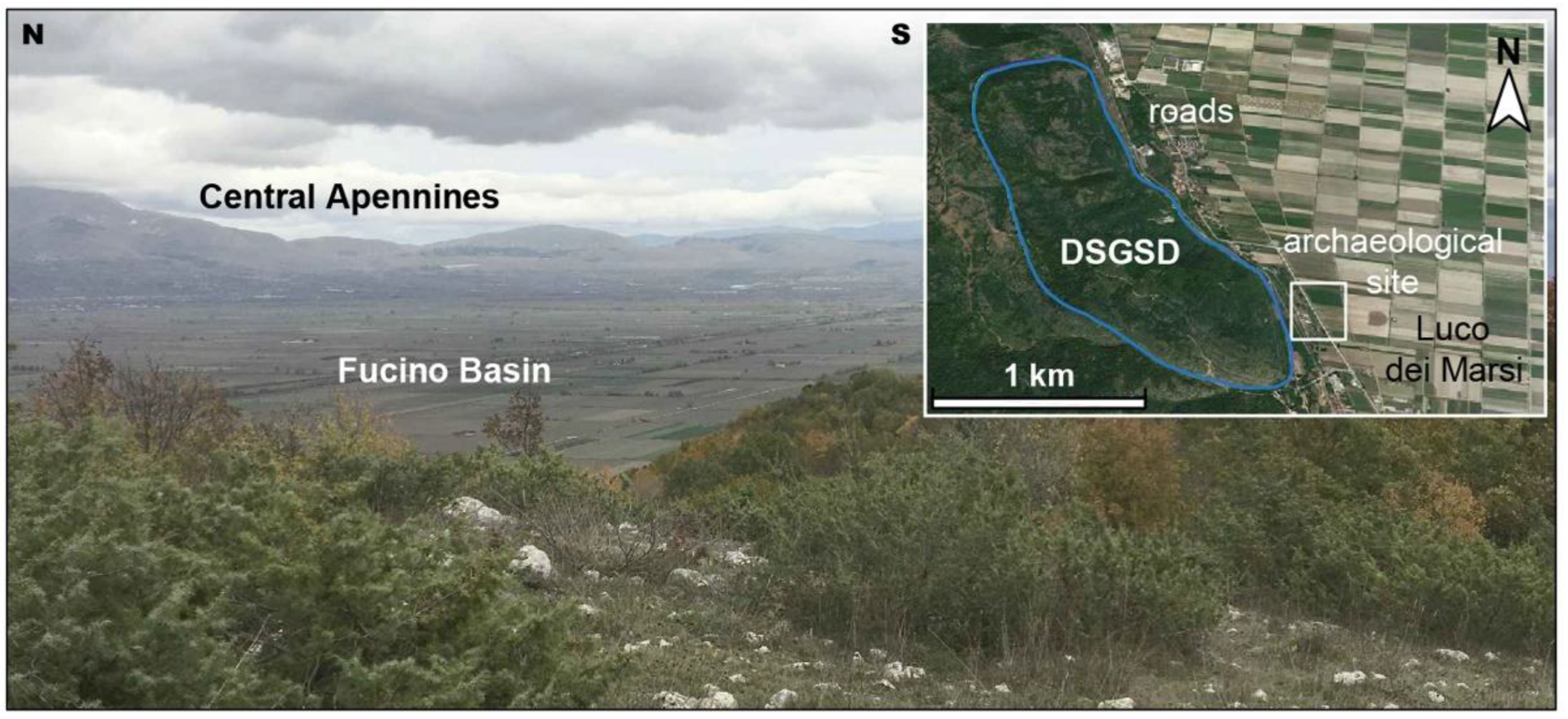
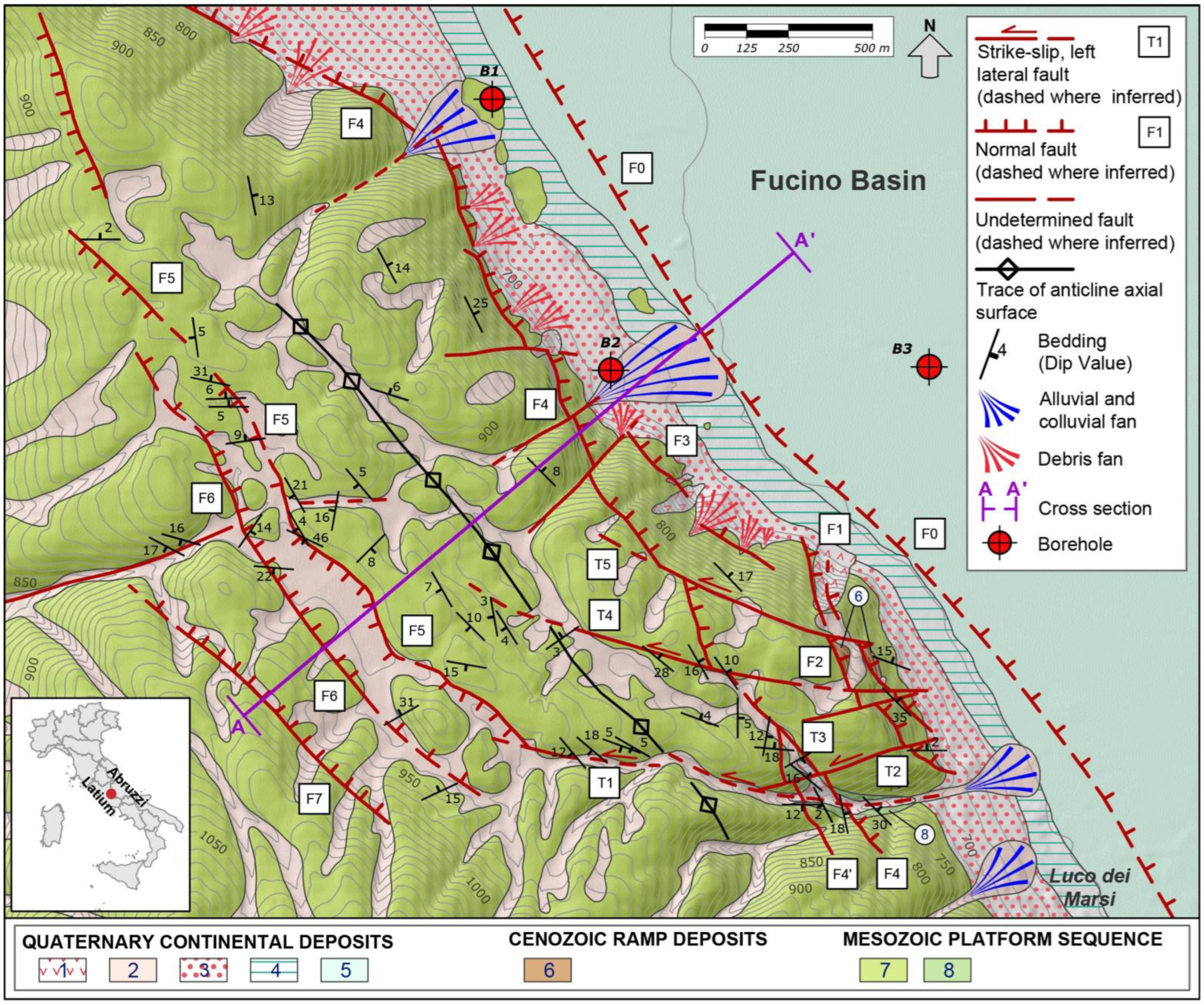

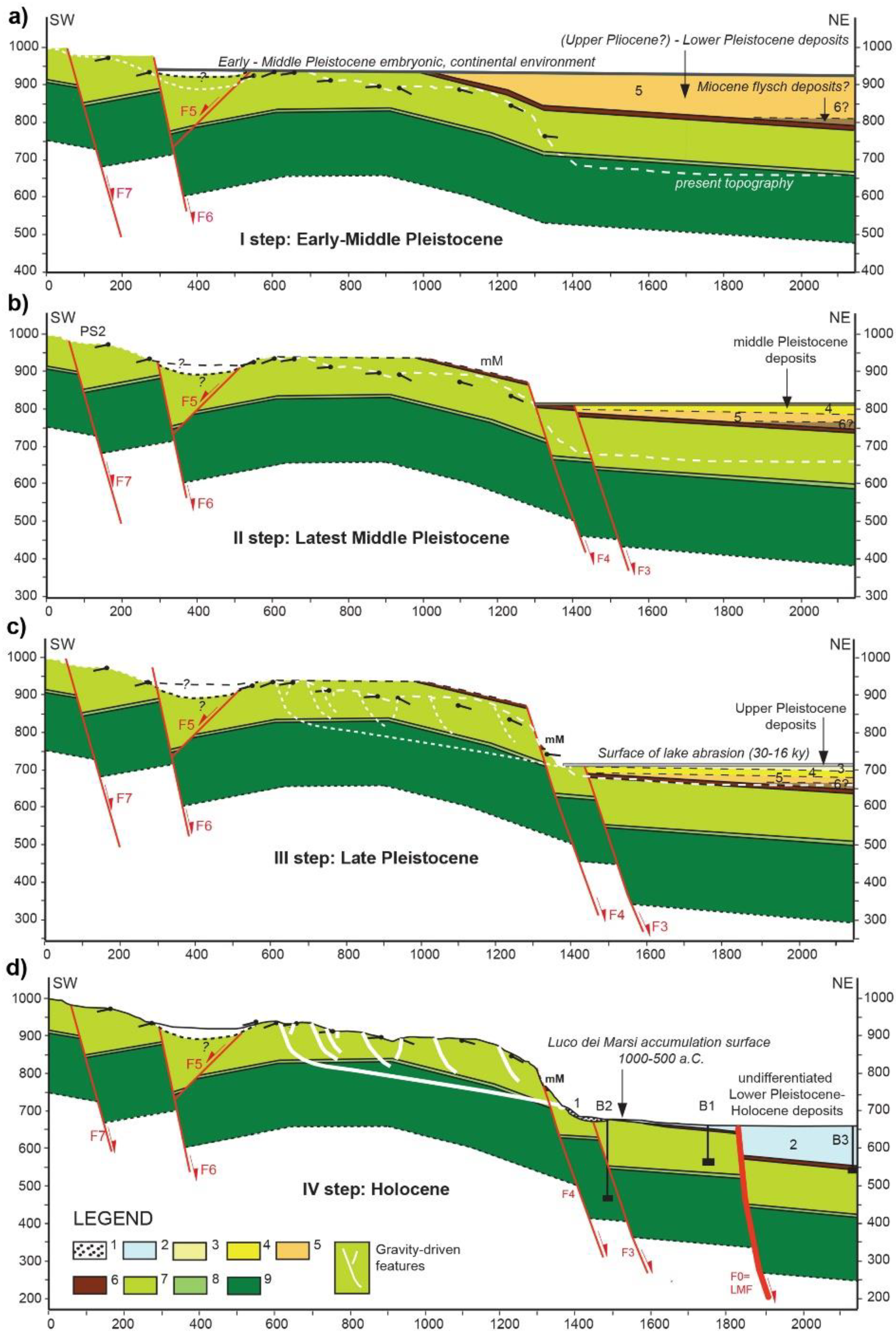
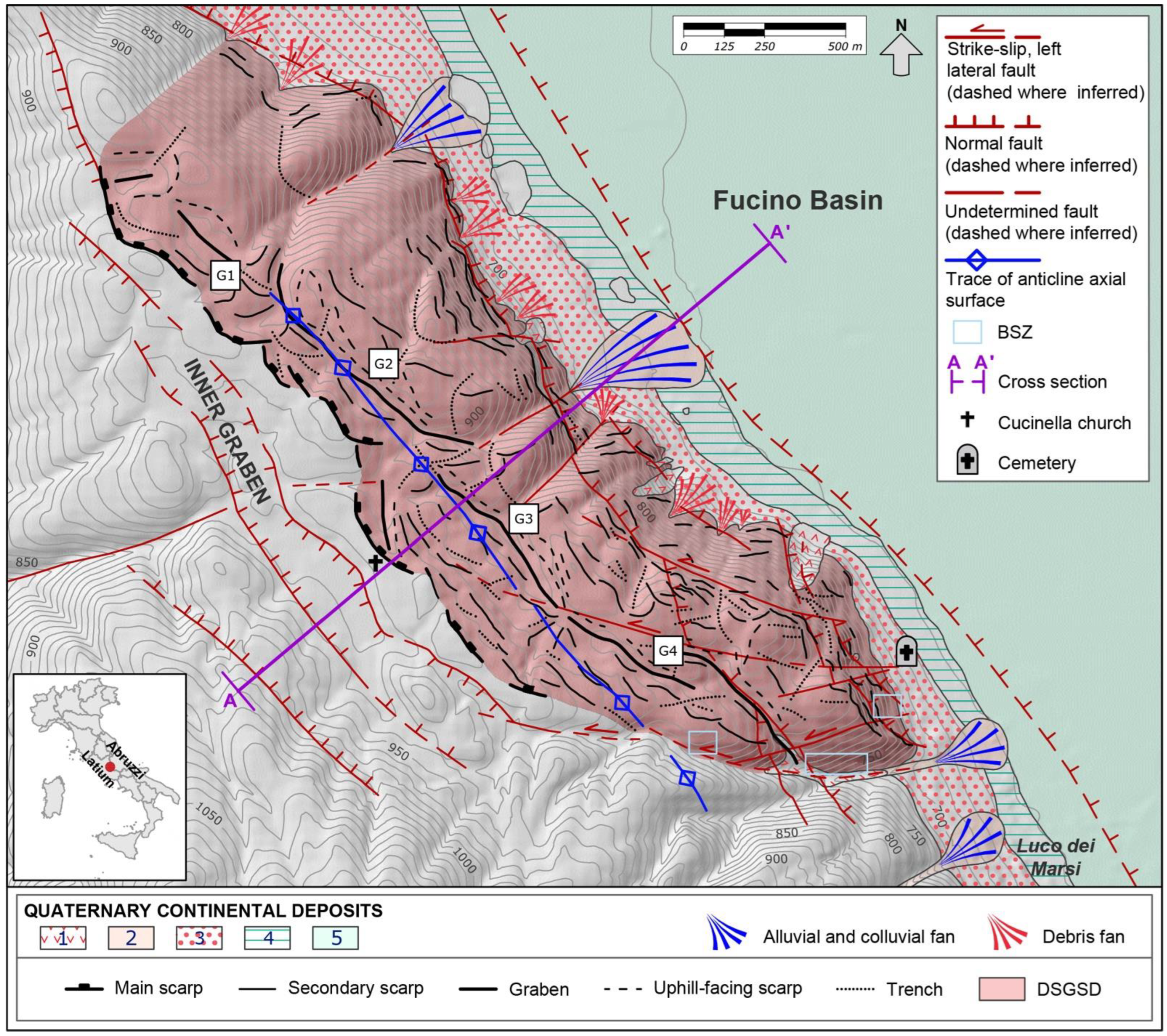
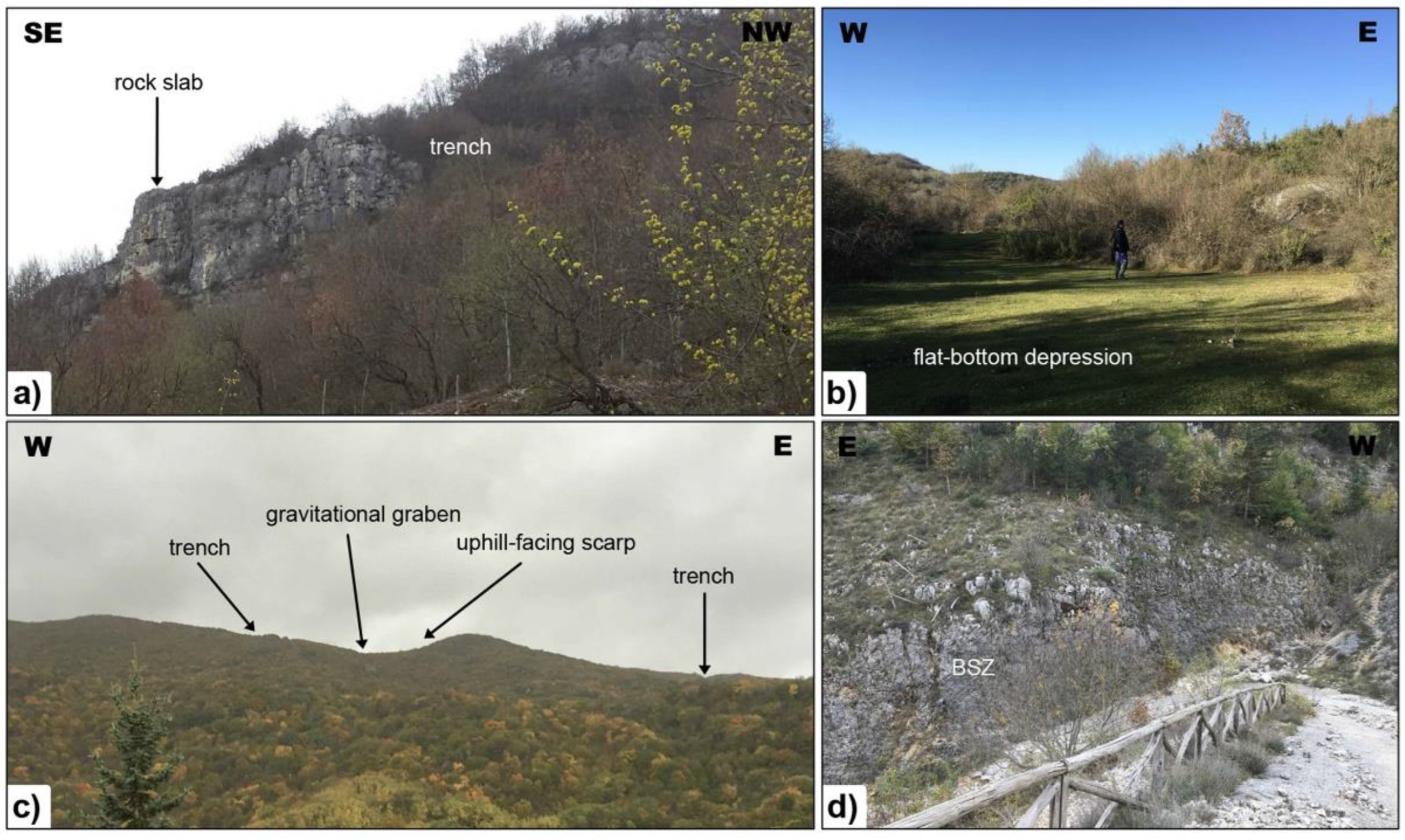
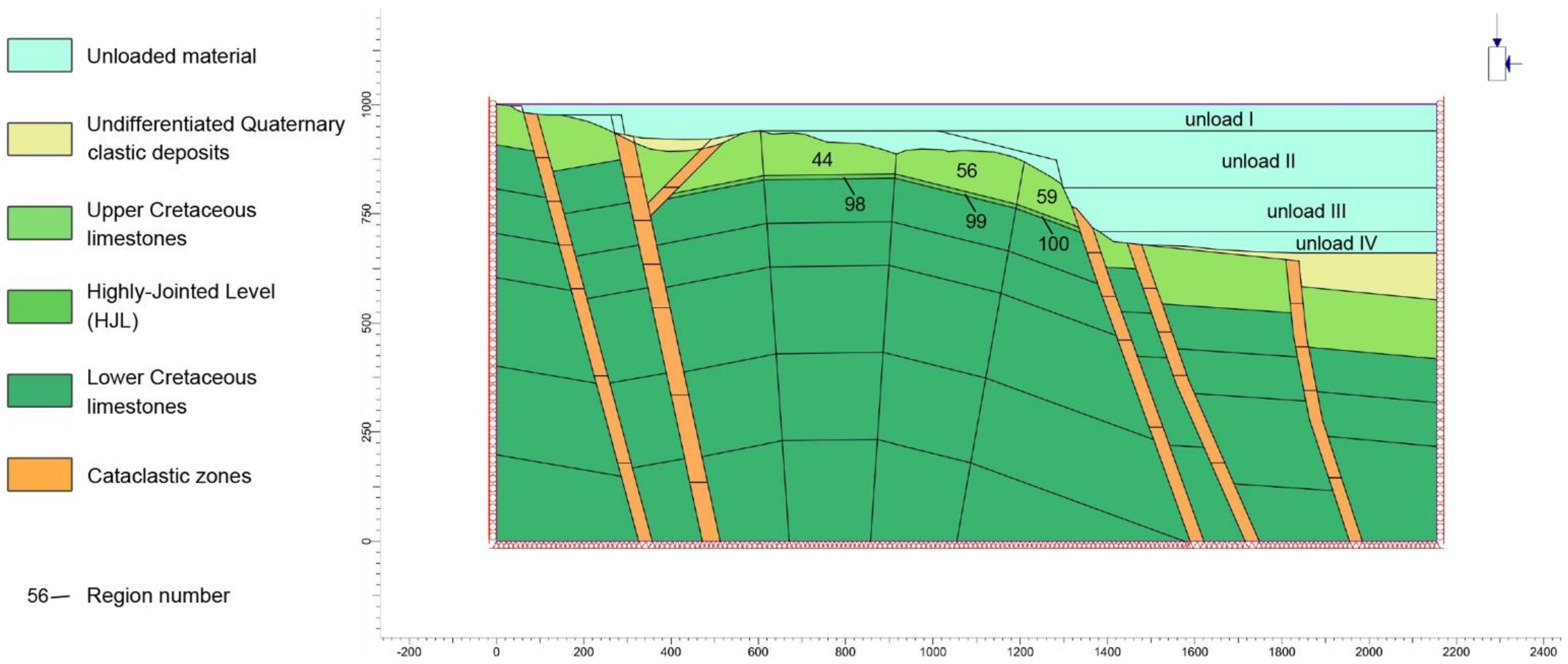






Disclaimer/Publisher’s Note: The statements, opinions and data contained in all publications are solely those of the individual author(s) and contributor(s) and not of MDPI and/or the editor(s). MDPI and/or the editor(s) disclaim responsibility for any injury to people or property resulting from any ideas, methods, instructions or products referred to in the content. |
© 2023 by the authors. Licensee MDPI, Basel, Switzerland. This article is an open access article distributed under the terms and conditions of the Creative Commons Attribution (CC BY) license (https://creativecommons.org/licenses/by/4.0/).
Share and Cite
Discenza, M.E.; Di Luzio, E.; Martino, S.; Minnillo, M.; Esposito, C. Role of Inherited Tectonic Structures on Gravity-Induced Slope Deformations: Inference from Numerical Modeling on the Luco dei Marsi DSGSD (Central Apennines). Appl. Sci. 2023, 13, 4417. https://doi.org/10.3390/app13074417
Discenza ME, Di Luzio E, Martino S, Minnillo M, Esposito C. Role of Inherited Tectonic Structures on Gravity-Induced Slope Deformations: Inference from Numerical Modeling on the Luco dei Marsi DSGSD (Central Apennines). Applied Sciences. 2023; 13(7):4417. https://doi.org/10.3390/app13074417
Chicago/Turabian StyleDiscenza, Marco Emanuele, Emiliano Di Luzio, Salvatore Martino, Mariacarmela Minnillo, and Carlo Esposito. 2023. "Role of Inherited Tectonic Structures on Gravity-Induced Slope Deformations: Inference from Numerical Modeling on the Luco dei Marsi DSGSD (Central Apennines)" Applied Sciences 13, no. 7: 4417. https://doi.org/10.3390/app13074417
APA StyleDiscenza, M. E., Di Luzio, E., Martino, S., Minnillo, M., & Esposito, C. (2023). Role of Inherited Tectonic Structures on Gravity-Induced Slope Deformations: Inference from Numerical Modeling on the Luco dei Marsi DSGSD (Central Apennines). Applied Sciences, 13(7), 4417. https://doi.org/10.3390/app13074417







